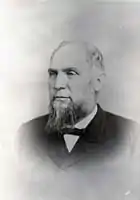George Washington Glick | |
|---|---|
 | |
| 9th Governor of Kansas | |
| In office January 8, 1883 – January 12, 1885 | |
| Lieutenant | David W. Finney |
| Preceded by | John St. John |
| Succeeded by | John A. Martin |
| Member of the Kansas State Legislature | |
| In office 1862 | |
| Personal details | |
| Born | July 4, 1827 Fairfield County, Ohio |
| Died | April 13, 1911 (aged 83) Atchison, Kansas |
| Political party | Democratic |
| Spouse | Elizabeth Rider |
| Profession | Attorney, politician |
George Washington Glick (July 4, 1827 – April 13, 1911) was the ninth Governor of Kansas.[1]
George Washington Glick was raised on his father's farm near Greencastle, Ohio. He enlisted for service in the Mexican–American War, but saw no action. At age 21 he began studying to become an attorney at the law offices of Buckland and Hayes (later President Rutherford B. Hayes); he was admitted to the bar two years later and established a moderate law practice, earning a reputation as a hard-working lawyer. Glick moved to Atchison, Kansas, in 1859 and formed a partnership with Alfred P. Otis. He served as a Union soldier in the 2nd Kansas Infantry during the Civil War. Elected to the Kansas State Legislature in 1862, he served for 14 of the next 18 years and was Speaker pro tempore in 1876. He served in both houses of the state legislature. Glick was well respected and considered "just and expert" by his colleagues.[2]
He was elected Governor in 1882 and served until 1885. He was also, despite being the 9th governor overall, only the first Democrat to serve as governor of Kansas. Legislation enacted during his tenure included the creation of a railroad commission, a "good roads" law, reassessment of tax laws, and the establishment of a livestock sanitary commission. He was later appointed pension agent in Topeka by President Grover Cleveland.
After 15 years of civic service, George Glick was forced to abandon his political career because of a throat infection that nearly destroyed his ability to speak. He continued, however, as an attorney for various railroads. He also managed his farm and served as a charter member and first vice president of the Kansas Historical Society.
In 1900, he was nominated to run for the US Congress against Charles Curtis.[3] Curtis, a very popular figure who had just authored the Gold Standard Act,[4] won.
Glick died in 1911 in Atchison, Kansas.[5]
Statue replacement
In 1914, the state of Kansas donated a marble statue of Glick to the U.S. Capitol's National Statuary Hall Collection as one of its two allowed entries. The statue was sculpted by Charles Niehaus, who sculpted seven other statues for the collection, including Kansas's other entry, Senator John J. Ingalls in 1905. In 2003, Kansas became the first state to replace a statue when it replaced Glick with a bronze of former president Dwight D. Eisenhower. Glick's statue was moved to the Kansas History Center in Topeka.[6]
Notes
- ↑ "Kansas Legislators Past & Present – Gis through Gref, State Library of Kansas". Kslib.info. Archived from the original on November 25, 2010. Retrieved 2010-08-09.
- ↑ Lawrence Kestenbaum. "Index to Politicians: Glennda to Glotzbach". The Political Graveyard. Retrieved August 9, 2010.
- ↑ Dean, Virgil W. (January 11, 2024). "Kansas Governors".
- ↑ Hatfield, Mark O. (January 11, 2024). "Vice Presidents of the United States Charles Curtis (1929-1933)" (PDF).
- ↑ "Archived copy". Archived from the original on December 11, 2010. Retrieved September 12, 2009.
{{cite web}}: CS1 maint: archived copy as title (link) - ↑ Rothschild, Scott (June 9, 2003). "State's statue swap moves ex-governor into obscurity". Lawrence Journal-World. Retrieved December 31, 2014.
External links
- Glick speeches on State Library of Kansas web site
- Publications concerning Kansas Governor Glick's administration available via the KGI Online Library.
- George Washington Glick at Find a Grave
